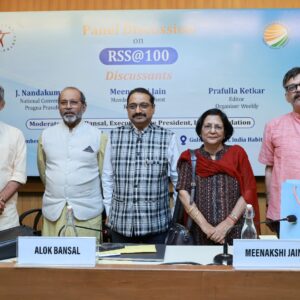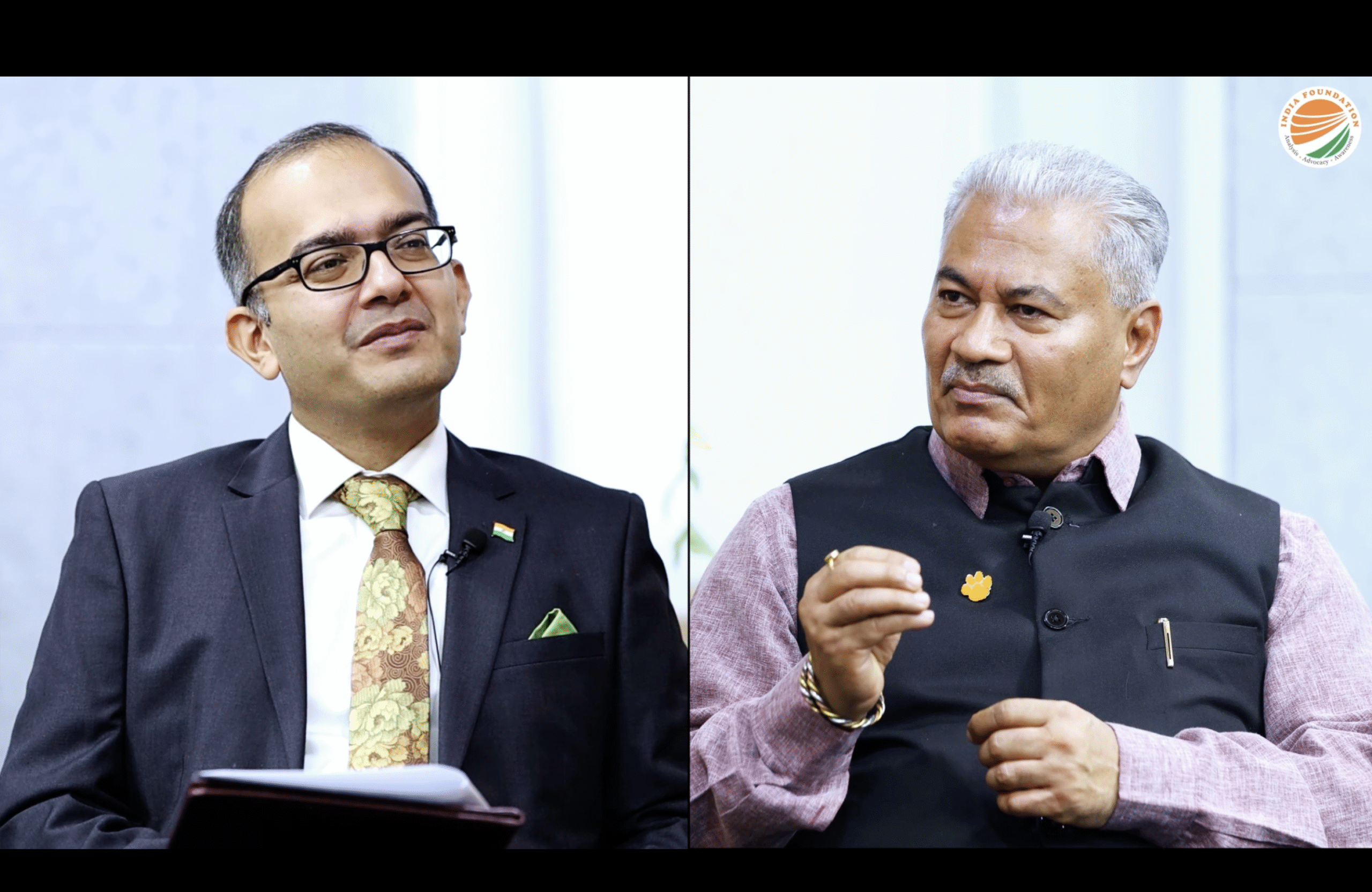
 India Foundation in collaboration with International Chamber of Commerce organised the 2nd India Economic Convention on the theme, ‘Architecture for Growth’ at Taj Palace Hotel, New Delhi on 17-18 September, 2015.
India Foundation in collaboration with International Chamber of Commerce organised the 2nd India Economic Convention on the theme, ‘Architecture for Growth’ at Taj Palace Hotel, New Delhi on 17-18 September, 2015.
The event was graced by the presence of senior ministers of the government including Shri Arun Jaitley, Union Minister of Finance, Government of India, Shri Ravi Shankar Prasad Union Minister of Telecom & IT, Smt. Nirmala Sitharaman, Union Minister of State with Independent Charge, Commerce and Industry, Shri Rajiv Pratap Rudy, Union Minister of State with Independent Charge, Skill development, and Shri Jayant Sinha, Union Minister of State for Finance.
 The convention was inaugurated by Union Finance Minister Arun Jaitley where he laid bare the direction of the government’s economic transformation programme which focuses on beefing up agriculture by giving a thrust to rural infrastructure and irrigation and hastening the pace of reforms for facilitating business, ushering in GST, putting in place a bankruptcy code, expediting dispute resolution through arbitration and bringing in transparent and fair public procurement laws. Addressing global and Indian CEOs at the ‘India Economic Convention, the Finance Minister said that the present government was totally clear on the direction that economic governance of the country needs to take. “We have sought to restructure the model of governance which takes the burden of employment off a fragile agriculture sector; one which forces the pace of development of the services and urban sector and builds a vibrant manufacturing sector, he said .
The convention was inaugurated by Union Finance Minister Arun Jaitley where he laid bare the direction of the government’s economic transformation programme which focuses on beefing up agriculture by giving a thrust to rural infrastructure and irrigation and hastening the pace of reforms for facilitating business, ushering in GST, putting in place a bankruptcy code, expediting dispute resolution through arbitration and bringing in transparent and fair public procurement laws. Addressing global and Indian CEOs at the ‘India Economic Convention, the Finance Minister said that the present government was totally clear on the direction that economic governance of the country needs to take. “We have sought to restructure the model of governance which takes the burden of employment off a fragile agriculture sector; one which forces the pace of development of the services and urban sector and builds a vibrant manufacturing sector, he said .
Mr. Jayant Sinha, Minister of State for Finance, in his address, dwelt on how the growth model adopted by the government was different from that of the past. “Our government wants to build India’s productive capacity to achieve and sustain an 8‐10% growth steadily through boom and bust cycles. Our approach is to power growth through supply‐side interventions and investments, rather than a consumption‐led, demand‐side orientation.” He said that the present government was pro‐poor, pro‐market. He referred to major government initiatives, such as, the financial inclusion programme ‐‐ Jan Dhan Yojna, which has brought millions of people into the financial system.. Referring to financing of MSMES, he cited the instance of Mudra Yojna as one of the first steps the government has taken to address this issue.

 Mr. Sunil Bharti Mittal, Chairman, Bharti Enterprises and ICC First Vice Chairman, exhorted Indian and global investors to cash in on the opportunities that have opened up through the launch of programmes such as Make in India, Digital India, Skill India and ‘Swachch Bharat Mission’.
Mr. Sunil Bharti Mittal, Chairman, Bharti Enterprises and ICC First Vice Chairman, exhorted Indian and global investors to cash in on the opportunities that have opened up through the launch of programmes such as Make in India, Digital India, Skill India and ‘Swachch Bharat Mission’.
Ms Naina Lal Kidwai, Executive Director on the board of HSBC Asia‐Pacific and Chairman India, HSBC Ltd pointed out some of the structural issues saying that although “the RBI has brought down the interest rate by 75 basis points but the transmission rate is quite low”. She said that it takes approximately 18 months for the deposits to reach the beneficiaries under the current system.
The Government of India is working towards removing obstructions that have led to stagnation in the growth of manufacturing sector. Manufacturing needs to be given the necessary push as the new entrants in the job market cannot be absorbed by agriculture or services sector. Along with the state governments, the Centre was focusing on removing the policy impediments and red tapism to boost investments and realize the goals of ‘Make in India’, said Mrs. Nirmala Sitharaman, Minister of State (Independent Charge) for Commerce & Industry, while addressing the session on ‘What will “Make in India” look like’ at the India Economic Convention 2015. Ms. Sitharaman said that India’s demographic dividend was one of its advantages and the government was aiming to impart skills to youth. It was expected that this initiative would reach its fruition n the next 5‐10 years, and a skilled and employable workforce would be ready to join the market.
Digital India is a transformational programme which has been launched in a mission mode to bridge the digital divide between the haves and have nots, said Mr Ravi Shankar Prasad, Union Minister for Communication and Information Technology at the India Economic Convention 2015. “Digital India is politics neutral,” Mr Prasad said even as he highlighted the government’s achievements in strengthening Digital India to “empower India as well as Indians”. The minister, in his address during the panel discussion entitled: ‘Is India’s Digital Revolution a panacea to its infrastructure challenges’, said that the government through its Bharat Net initiative is creating a digital architecture for delivery of services to common man. Nearly 9,000 km of work under the programme has been completed in the past 14 months, he said. He cited the example of a recently launched programme ‘Digital Pramanam’ to highlight how digitisation has been helping thousands of pensioners by eliminating the requirement for them to get physically verified that they are alive in order to claim their pension. Mr Prasad said that people in India are waiting for Digital India to become a success as the “initiative gives them a voice”. He also said that electronic manufacturing in India has immense potential. “We have approved 20 electronic clusters and now the state governments are competing to get more approved,” he said. The minister informed that Rs 104,000 crore worth of electronic manufacturing proposals are under consideration of the government.
Mr. Rajiv Pratap Rudy, Minister of State (Independent Charge) for Skill Development and Entrepreneurship, urged the private sector to partner with the government to drive the ‘Skill India’ movement at a fast pace to match industry’s demand for skilled workers. He informed that a portal would be launched soon by the Ministry to facilitate the Skill India initiative. While addressing a session on ‘Skilling India: How and When’ at India Economic Convention, Mr. Rudy said that the private sector needs to spell out the skills required by them only then would the government be able to provide them with the requisite workforce. He added that there was also a need for trainers as teachers and professors were not adequately equipped to impart skills. Hence, the government was accessing the skills of ex‐servicemen who had the necessary skills to train workforce in numerous fields. Speaking on the need for infrastructure to impart skills, Mr. Rudy said that the Skill Development and Entrepreneurship Ministry was not in a position to build new infrastructure and therefore it was looking at leveraging the existing infrastructure such as with the railways, which already had 43000 kms of optical fibre network. Also, states need to be on board to link training with jobs, he said.
India can emerge as a key provider of high end analytics based on genomics big data, stated Mr. Vijay Raghavan, Secretary, Department of Biotechnology, Ministry of Science & Technology, Government of India, at an interactive session on biotechnology on day two of the ‘Indian Economic Convention’ in association with Niti Aayog, There is a big opportunity for India to both analyse and model genomics big data and to build mechanisms for using the analytics, said Mr. Raghavan and pointed out that India should also look to build a sizeable pool of people who are trained to handle computational genomics.
In another interactive session on Indian Railways, Mr. Girish Pillai, Advisor‐Infrastructure, Indian Railways, highlighted some of the key features of the Railways’ five‐year Action Plan. He said that the National Transport Development Policy Committee has estimated that the Indian Railways would require about Rs. 32,00,000 crore worth of investment till 2032. “We need to increase the investment 3‐5 times,” he added.
In the session ‘Indian space initiatives’, Dr. A S Kiran Kumar, Chairman, ISRO, said that it was essential to build capacity to bring technology for the benefit of the country. He informed that an Indian Industry Consortium would be formed soon to launch space vehicles and teams have been set up to discuss and finalize the details. Dr. Kumar said that government departments were being encouraged to utilize space technology and available information for carrying out their day to day duties effectively and now 60 departments were employing the technology in their daily work.
Dr. UR Rao, Chairman of the Governing Council of the Physical Research Laboratory and Former Chairman, ISRO, in his presentation narrated the fascinating journey of ISRO over the decades. Highlighting the needs of the future, he said space technology should be employed for new applications such as expansion of tele education and tele medicine; for disaster monitoring and management; management of communicable diseases’ resource identification, efficient management of financial operations; management of forestry and water resources and management of agriculture.
At last Dr. Arvind Panagariya, Vice Chairman, Niti Aayog, said that Niti Aayog was at a nascent stage and was working on different fronts with knowledge institutions and think tanks at various levels.
The convention was a unique platform where the national & international industrial leaders came together to brainstorm and the event was showered with appreciation from all corners of the economic world. All the sessions lead to a fruitful outcome in terms of resolution of the current issues in the road to success.




